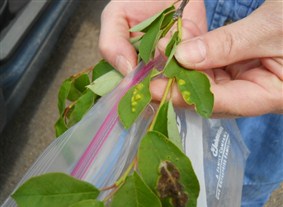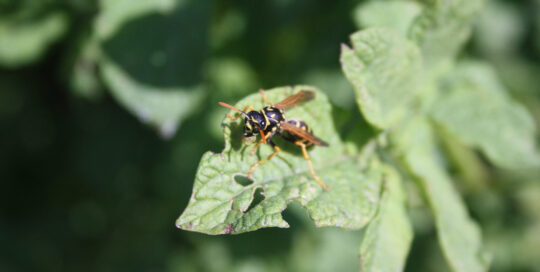Galls on the Chokecherries
Views: 5677

I’m closely involved with the Master Gardener program in Cascade County, because many of the folks who go through the classes volunteer in the community gardens in order to earn their certification. It’s a blessing because many are experienced gardeners who are more than happy to share their experiences with me. Plus it expands the opportunity to learn the answer to problems I haven’t had myself like infected chokeberries.
Infected Chokecherries
This week, a lady told me she had issues with her chokecherries. She said they had what looked like eggs and galls on them last year, so she sprayed it with a fungicide and was pruning mercilessly. I wasn’t aware of anything attacking chokecherries, a native to this area, so I was intrigued.
I have to admit, I was also concerned because we planted some last year. After waging the battle with fire blight on the apples, I didn’t want a new wave of disease on another set of trees.
I asked her to bring me samples to one of the community gardens where we were planting an herb garden. It was nasty looking. One of the samples definitely looked like it was covered with little eggs. The other ones had a blistering type of yuckiness. (Notice the highly technical terminology.) I had no idea what it was so I sent the photos to Toby Day, our Montana State University Extension horticulturalist specialist. He’s a very knowledgeable guy who sees just about everything as he travels across the state. I figured he’d know whats up.
Eriophyid mites
Sure enough, he told me it’s certainly not a fungus. He said it’s most likely a Eriophyid mite. There are a multitude of subspecies that attack everything from tomatoes to willows, and it’s a fairly common pest.
Actually, from the information and links he sent to me, I recognize it on maples and even apples. The egg-like looking specks on the first sample she showed me are finger galls. Theyre gross looking and you just want to scrape them off with your fingernail. The second examples are blister galls. They don’t look much better so I can see why the lady was very concerned.
The good news is it isn’t some horrid disease that is going to defoliate the remaining living trees in Central Montana. The mite damage is mostly cosmetic, and it typically wont stress the tree or plant too severely. Toby said you don’t need to prune out the affected foliage, and really dont have to do much of anything at this time of year.
He recommended cleaning up the leaves under the bushes (or trees) to reduce the chances of the mites to overwinter in the area. Then next spring its important to spray the trees with a dormant oil spray. You’ll do this prior to bud break. This will smother out the little darlings that might have survived. If it’s a particularly severe infestation a second dose of a horticultural or insecticidal soap spray just as the leaves are beginning to unfurl should do the trick.
Meet Amy Grisak
Amy is a freelance author and photographer in Great Falls, MT who specializes in gardening, foods, and sustainable agriculture. She provides information on every kind…
Amy's Recent Posts

Looking into the Crystal Ball for a Pest Report








